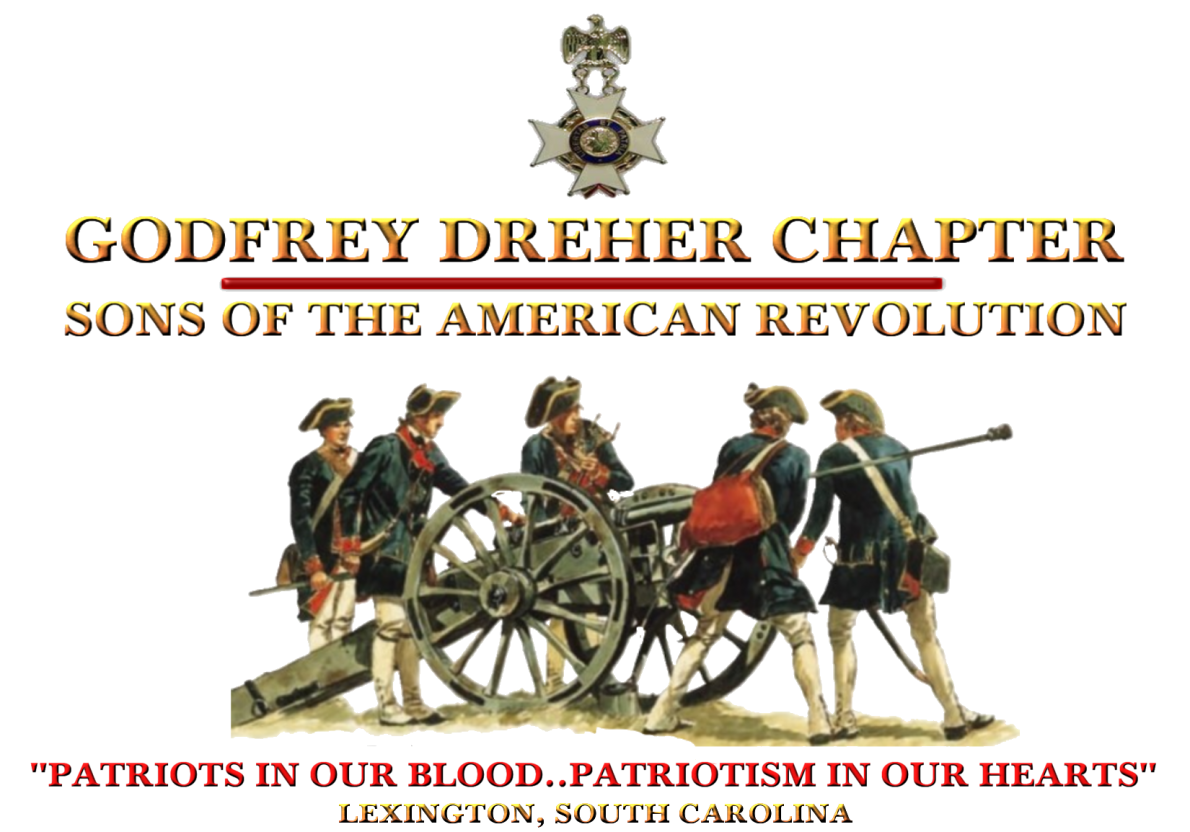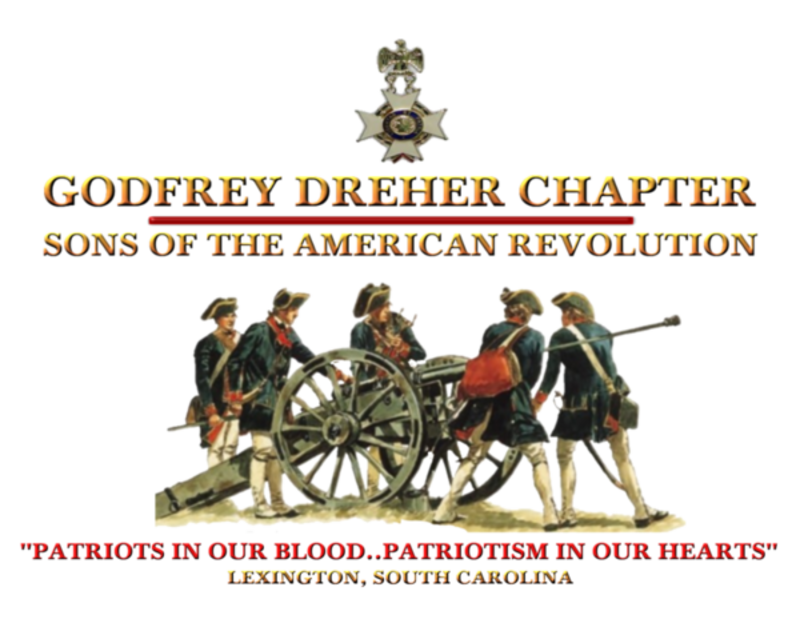



The National Society Sons of the American Revolution (NSSAR)
The Sons of the American Revolution is the leading male lineage society that perpetuates the ideals of the war for independence. As a patriotic, historical, and educational non-profit corporation, it seeks to maintain and expand the meaning of patriotism, respect for our national symbols, the value of American citizenship, and the unifying force of “e pluribus unum” that was created from the people of many nations.
In 1876, there were many celebrations to commemorate the centennial of the signing of the Declaration of Independence on July 4, 1776. As part of this patriotic fervor, a group of men in the San Francisco, California, area who were descendants of patriots involved in the American Revolution, formed an organization called the Sons of Revolutionary Sires. Their objective was to have a fraternal and civic society to salute those men and women who pledged their lives, fortunes, and sacred honor to the battle for independence from Great Britain. The Sons of Revolutionary Sires desired to keep alive their ancestors’ story of patriotism and courage in the belief that it is a universal one of man’s struggle against tyranny – a story which would inspire and sustain succeeding generations when they would have to defend and extend our freedoms.

Out of the Sons of Revolutionary Sires grew the National Society of the Sons of the American Revolution, which was organized on April 30, 1889, the one hundredth anniversary of the inauguration of George Washington as our nation’s first president. We have used the acronym SAR to identify ourselves for over one hundred years. The SAR was conceived as a fraternal and civic society composed of lineal descendants of the patriots who wintered at Valley Forge, signed the Declaration of Independence, fought in the battles of the American Revolution, served in the Continental Congress, or otherwise supported the cause of American Independence. The National Society was chartered by an Act of the United States Congress on June 9, 1906. The charter was signed by President Theodore Roosevelt, who was also a member of the Empire State Society, SAR. The charter authorizes the granting of charters to societies of the various states and territories and authorizes the state-level societies to charter chapters within their borders. Federal legislation then established a federal charter for the National Society, SAR.
On February 23, 2008, under the leadership of President General Bruce A. Wilcox, the SAR general officers, vice presidents general, and trustees voted to take the first step to relocate the SAR national Headquarters to West Main Street in Louisville. In October 2010, the Genealogical Research Library began operations in its new facility on West Main Street, with the full transition of the Headquarters to its current location occurring over the summer months of 2014. SAR headquarters are located along Main Street’s Museum Row in downtown Louisville, Kentucky. The historical buildings themselves, housing the SAR’s administrative offices, Library, and Center Gallery, showcase a cast iron façade in the Modified Renaissance Revival style prevalent in American architecture in the late nineteenth century.



The South Carolina Society Sons of the American Revolution (SCSSAR) was founded on April 18, 1889. SCSSAR is one of the founding members of the NSSAR. The SCSSAR consists of approximately 1000 members in community chapters throughout the State of South Carolina. The SCSSAR functions as the administrative and coordination laision between the SCSSAR chapters and the NSSAR, as well as, supports the chapters in collaborative inter-chapter community, state and national program efforts.

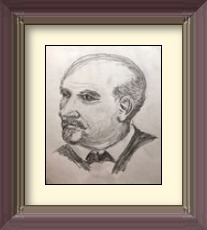
Governor John Peter Richardson, III
First President
South Carolina Society, Sons of the American Revolution
25 September 1829 to 6 July 1899
Founding of the South Carolina Society, Sons of the American Revolution
On 18 April 1889 twenty-five men met in the State House in Columbia, South Carolina, for the purpose of considering the forming of a state society dedicated to perpetuating the patriotic ideals that had led to the American Revolution and the founding of the United States of America. This meeting was called in response to an invitation from a special committee of the “Society of the Sons of the Revolution of New Jersey” to attend a meeting on 30 April 1889 (as a part of the centennial celebration of Washington’s inauguration as our first President) at the Fraunces Tavern in New York City. That day the men decided in favor of the formation of the state society and organized by appointing officers (including delegates to attend the meeting in New York City). Governor John Peter Richardson, III, was appointed the first President of the South Carolina Society. At the New York City meeting the National Society Sons of the American Revolution was formed and the South Carolina Society was one of the eleven State Societies who had organized prior to and supported the organization of the National Society.
Governor John Peter Richardson, III
John Peter Richardson, III, was the Governor of South Carolina from 1886 to 1890. It was during his term of Governor that the South Carolina Society SAR was founded and he was appointed its first President.
Richardson was born in Clarendon County, South Carolina to John Peter Richardson, II, a former Governor of South Carolina, and Juliana Augusta Manning. After graduating from South Carolina College in 1849, Richardson managed Elmswood Plantation in Clarendon County. He was also elected to the South Carolina House of Representatives during antebellum South Carolina.
With the outbreak of the American Civil War, Richardson enlisted in the Confederate Army in 1862 and was on the staff of Brigadier General James Cantey until the end of the war. After which, he was re-elected in 1865 to the South Carolina House of Representatives and later that year to the South Carolina Senate Richardson was inactive in politics when Radical Republicans ruled the state during Reconstruction, but returned in 1880 on the Democratic ticket running unopposed for state Treasurer.
In 1886, Clarendon County Democrats endorsed Richardson in his candidacy of governor. His nomination proceeded forward to the state Democratic convention where Lieutenant Governor John Calhoun Sheppard, who had the backing of Benjamin Tillman, opposed him. The recently formed Farmers’ Association had a major influence in the nomination and backed Richardson despite an attempt by Tillman to force them to support Sheppard. Richardson won the nomination on the third ballot and went on to win the gubernatorial election of 1886 to become the governor of South Carolina.
Again opposed by Tillman, Richardson managed win the Democratic nomination for a second term as governor with the support of 60% of the delegates and ran unopposed in the general election that fall. During his time as governor, agitation from the farmers of the state for reforms increased leading to the foundation of Clemson College in 1889 and the political rise of demagogue Ben Tillman.
On July 6, 1899, Richardson died in Columbia and was buried at Old Quaker Cemetery in Camden.

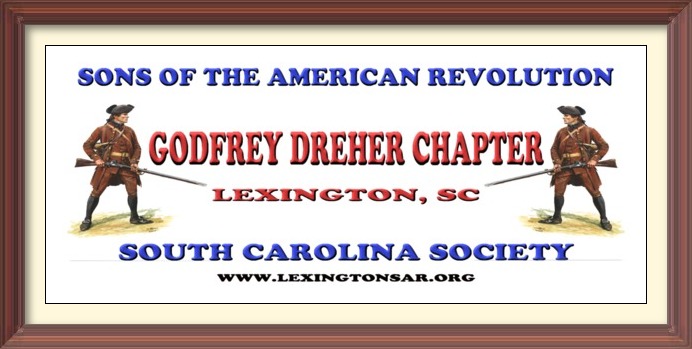

The Godfrey Dreher Chapter Sons of the American Revolution was chartered in October, 2009. The chapter meets in Lexington County, South Carolina. The chapter activities include a variety of programs to promote community patriotic, educational and historic interest in the American Revolution. Among the many programs are
- Essay contests for both nigh school students and Eagle Scouts,
- Medal presentations to college and high school R.O.T.C. students,
- Poster contests for elementary school students,
- American Revolution presentations to elementary and middle school students,
- Presentation of medals to public safety officials,
- Revolutionary War grave dedications, wreath laying and flag presentations,
- Volunteer work with veterans,
- Presentation of Flag Certificates to deserving organizations and schools,
- Participation in historic battle site observances,
- Participation in historic/patriiotic parades and events.

OUR CHAPTER PATRIOT – Godfrey Dreher (1720-1790)

The Dreher family journeyed across the sea to the colonies in 1744, but their linage can be traced back to 1626 in Emfingen of Württemberg Germany. Johannes Dreher, born in 1626 and his wife (Agatha Munz, dau. of Jacob & Barbara Munz) had four grandchildren and eleven great grandchildren. His sons, Gottfried & Hans George Dreher, left for the new world & arrived in the Carolina’s in 1744. Hans Jorge (John George) received a Kings grant of land near Crimms creek in Newberry County. John George Dreher and John Michael Stingle agreed to go back to the homeland to bring other German settlers back with them. John George secured 100 immigrants passage, and John Michael Stingle secured 150 more settlers. John George Dreher then returned to South Carolina on the ship Priscilla in 1754. Their first journey overseas to the Carolina colony had been a difficult trip. Though knowing how hard it was, these two thought it was worth traveling back to Germany to tell others about the opportunities in the new world. This time however, they had first-hand knowledge about the land in the Dutch Fork, the weather, and what they needed to bring.
Gottfried, grandson of Johannes & Agatha Munz Dreher & son of Andreas and Anna Maria Siger Dreher (both parents deceased before Gottfried was 10), arrived in Charleston in 1744 and applied for a land grant in the Saxe Gotha area in 1745 & a few months later was awarded a 150 acre grant in Saxe Gotha Township. If this was a “bounty grant”, the acreage suggests that he was married. Being a Wheelwright in the middle 1700’s was a well respected occupation and a necessity because carriages and wagons were the main mode of transportation. To create wheels, one had to have precise measuring skills and the talents of both a carpenter and a blacksmith. Gottfired Dreher started his career as a wheelwright in the Meidelstetten area of the Baden Wuettemburg, Germany.
He subsequently obtained land upstream and built a two story home and erected a stockade around his home and possibly the adjacent first Zion Lutheran Church (becoming known as “Fort Dreher”) in 1759 as a safe haven during Cherokee war (1757-61) and also against outlaws & subsequently the Tories. He erected an adjacent grits mill on Twelve Mile Creek near the Saluda River (I think it was where Corley Mile Road [the road in 2016] crosses Twelve Mile Creek just north of Zion Lutheran Church, known in the 1890s as the S. T. Lorick Mill site & subsequently being noted @ about 1900 on maps as Corleys Mill).
So, he was a very early member (likely a founding member) of Zion Lutheran Church, He erected a grits mill on Twelve Mile Creek near the Saluda River where modern Corley Mile Road crosses Twelve Mile Creek just north of Zion Lutheran Church. That mill became known in the 1890s as the S. T. Lorick Mill site and subsequently being noted by about 1900 on maps as Corley’s Mill. Dreher lived in a two story house almost at that mill site & Zion Church alongside (as the Indian Wars threatened, he built a stockade around the house and the church meeting house and it became known as “Dreher’s Fort”)…and that house sort of like a fort.
Children: Gottfried & Maria Barbara had four (4) daughters (Catherine, Anna Maria “Molly” Mary Ann & Anna) and two (2) sons (Capt. Godfrey Dreher & John Dreher).
Captain Godfrey Dreher, son of Gottfried, born in 1760, was a patriot and veteran of the Revolutionary War. He was just a teenager when he enlisted. Captain Dreher moved from the Dutch Fork to Georgia and was in the business, like his father, Gottlieb Dreher, of building water-powered mills. In 1813, Captain Dreher signed a contract in Louisiana to build waterpower mills for the Shepard Brown & Company. Records in Louisiana indicate that Dreher was a friend to John McDonugh. A McDonough family story says that John McDonough embezzled, cheated or stole Dreher’s money and Captain Dreher and his wife died in Algiers, Louisiana under suspicious circumstances, some suspected murder. The Dreher children were then placed in a Louisiana orphanage.
John Dreher, the brother of Captain Dreher, had a son who would impact the Lutheran Church in South Carolina. His name was Rev. Godfrey Walter Dreher. The German custom of naming the first-born son after the father and the fist born daughter after the mother can get someone researching genealogy really confused!
.

OTHER HISTORICAL ITEMS RELATED TO THE DREHER FAMILY

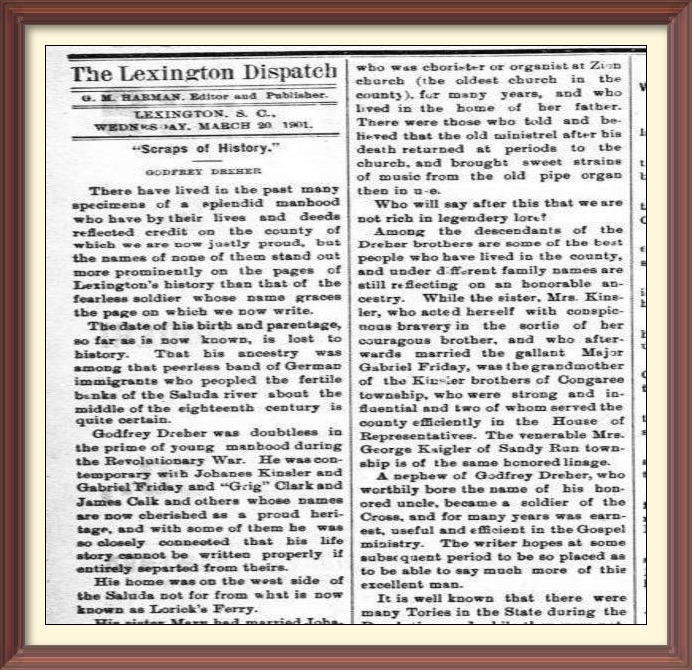

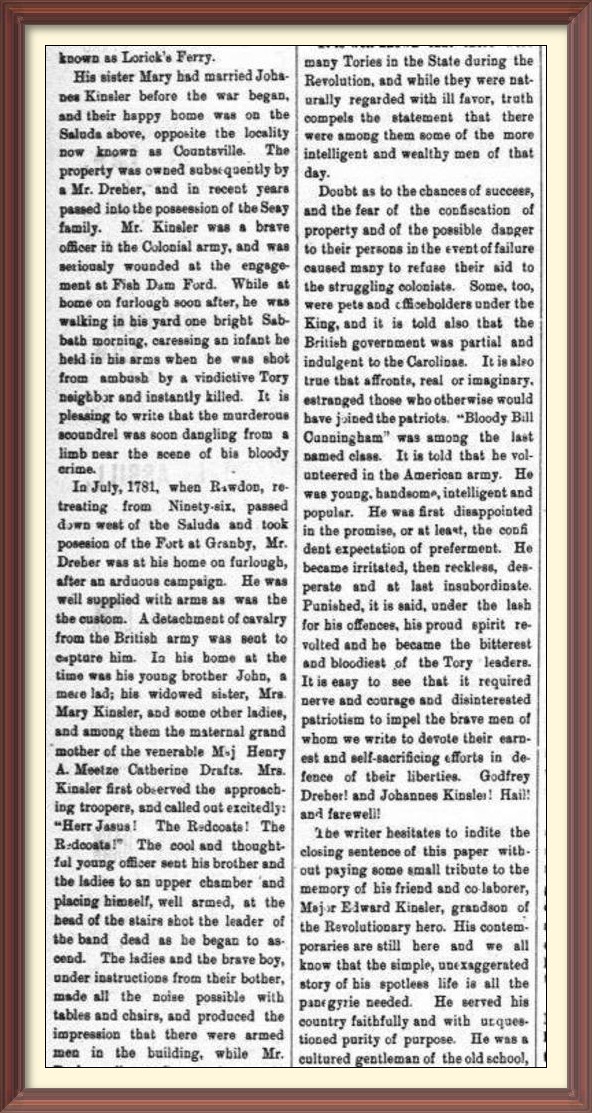

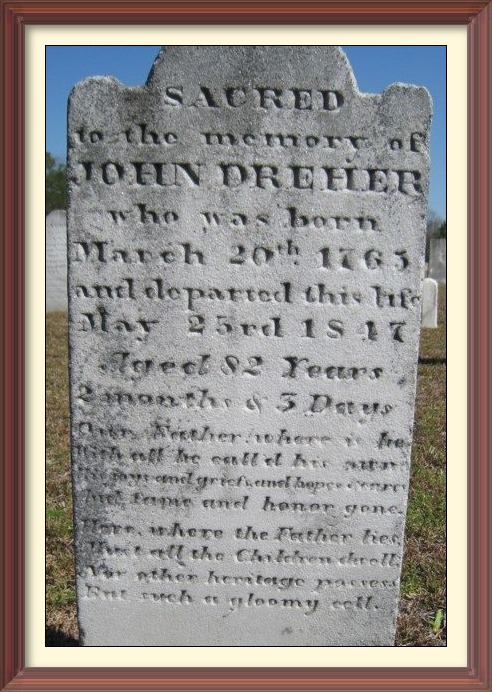
Tombstone of Revolutionary Was soldier John Dreher (1765-1847), son of Godfrey Dreher (1720-1798), brother of Captain Godfrey Dreher Junior (c1760-1815), and father of Reverend Godfrey Dreher (1789-1875). John’s mortal remains are buried at Saint Michaels Lutheran Church Cemetery at 400 River Road in Lexington County,

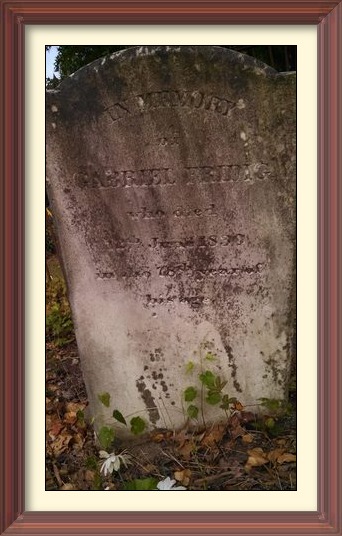
Graves in West Columbia of Revolutionary War Patriot Captain Gabriel Fridig or Friday and his wife Anna Mary Dreher Kinsler Fridig. Mary was the daughter of immigrant Godfrey Dreher and sister of Captain Godfrey Dreher. Mary’s first husband, Revolutionary War patriot Johanes Kinsler was wounded in the Battle of Fishdam Ford and was home recuperating when he was ambushed and murdered by a Tory. The widowed Mary was present when her brother Captain Godfrey Dreher drove away the detachment of Tories sent to capture him at his home.
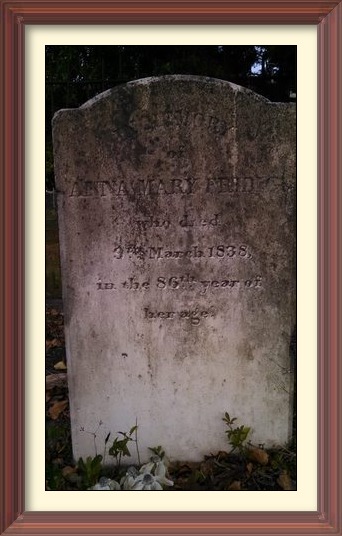

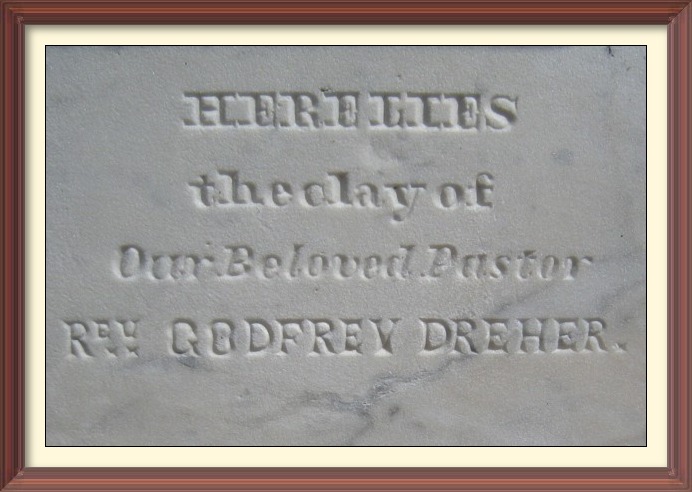
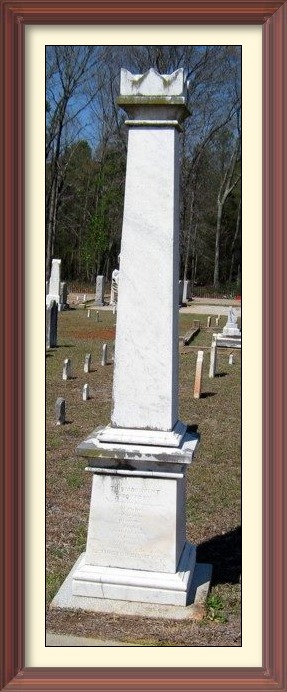

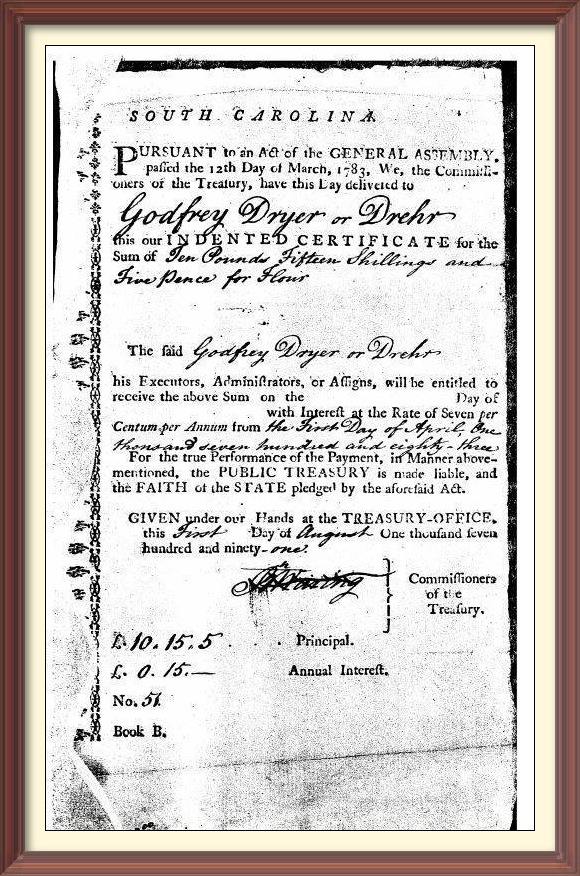
Godfrey Dreher’s record of providing flour to the South Carolina militia. Note that his name was spelled Dryer or Drehr on this document.

Plat for Godfrey Dryer for fifty acres between the Broad and Saluda Rivers in 1765.

